Analysis of Selection Procedures for Different Job Requirements
VerifiedAdded on 2019/09/20
|10
|2215
|457
Report
AI Summary
This report examines the critical role of tailored selection procedures in human resource management, emphasizing the need for different approaches based on job requirements. It delves into the recruitment and selection process, highlighting the importance of attracting and selecting the right candidates for specific roles. The report discusses the autocratic recruitment model and its components, as well as the basic principles of selection, including application screening, testing, and interviewing. It explores various selection tests such as ability, personality, and situational assessments, and analyzes how job analysis and job descriptions influence the selection process. The document concludes by emphasizing how the effective implementation of diverse selection procedures contributes to achieving organizational goals and objectives, ensuring the recruitment of employees with the required skills and capabilities for different job roles. The report references various sources to support its findings and conclusions.
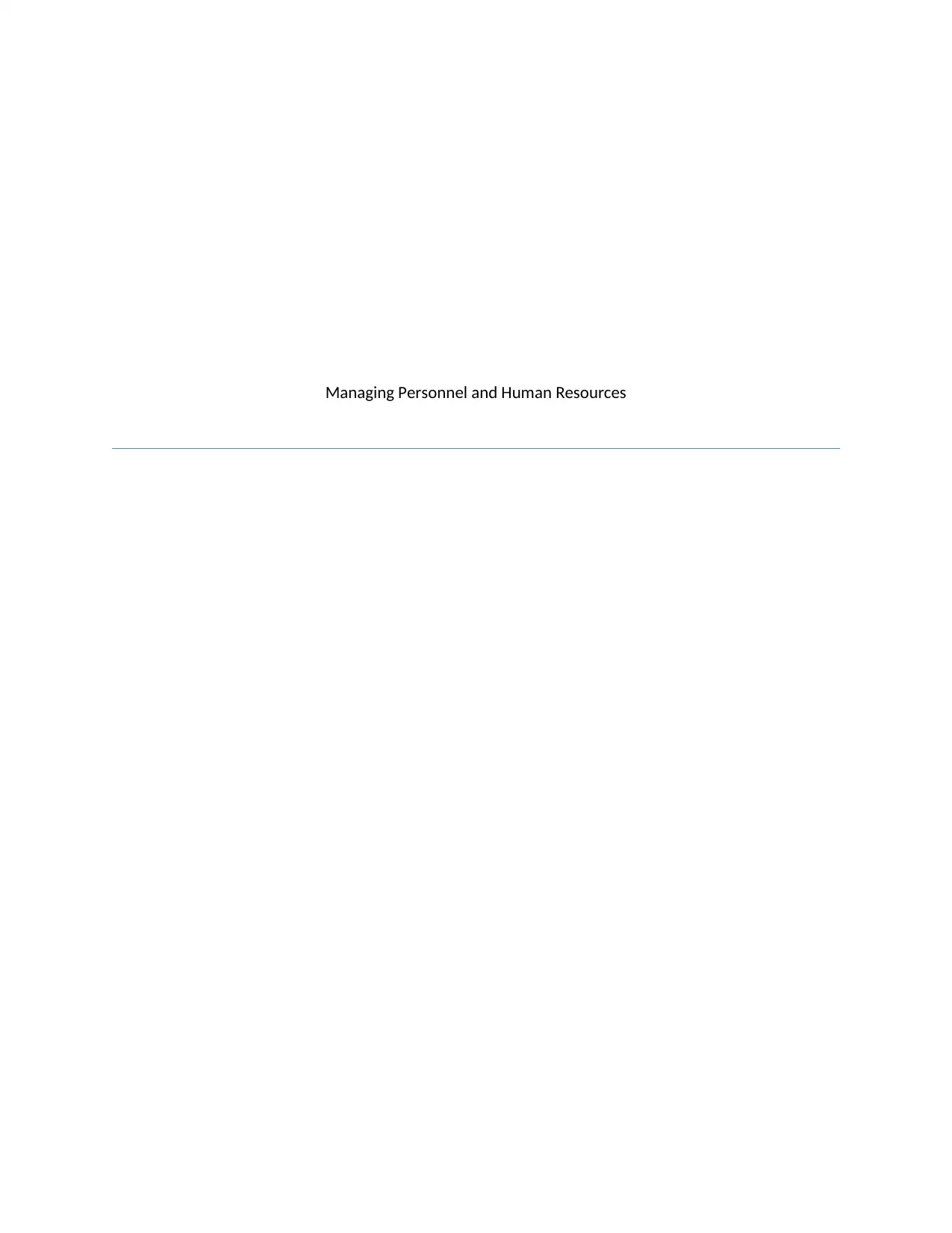
Managing Personnel and Human Resources
Paraphrase This Document
Need a fresh take? Get an instant paraphrase of this document with our AI Paraphraser
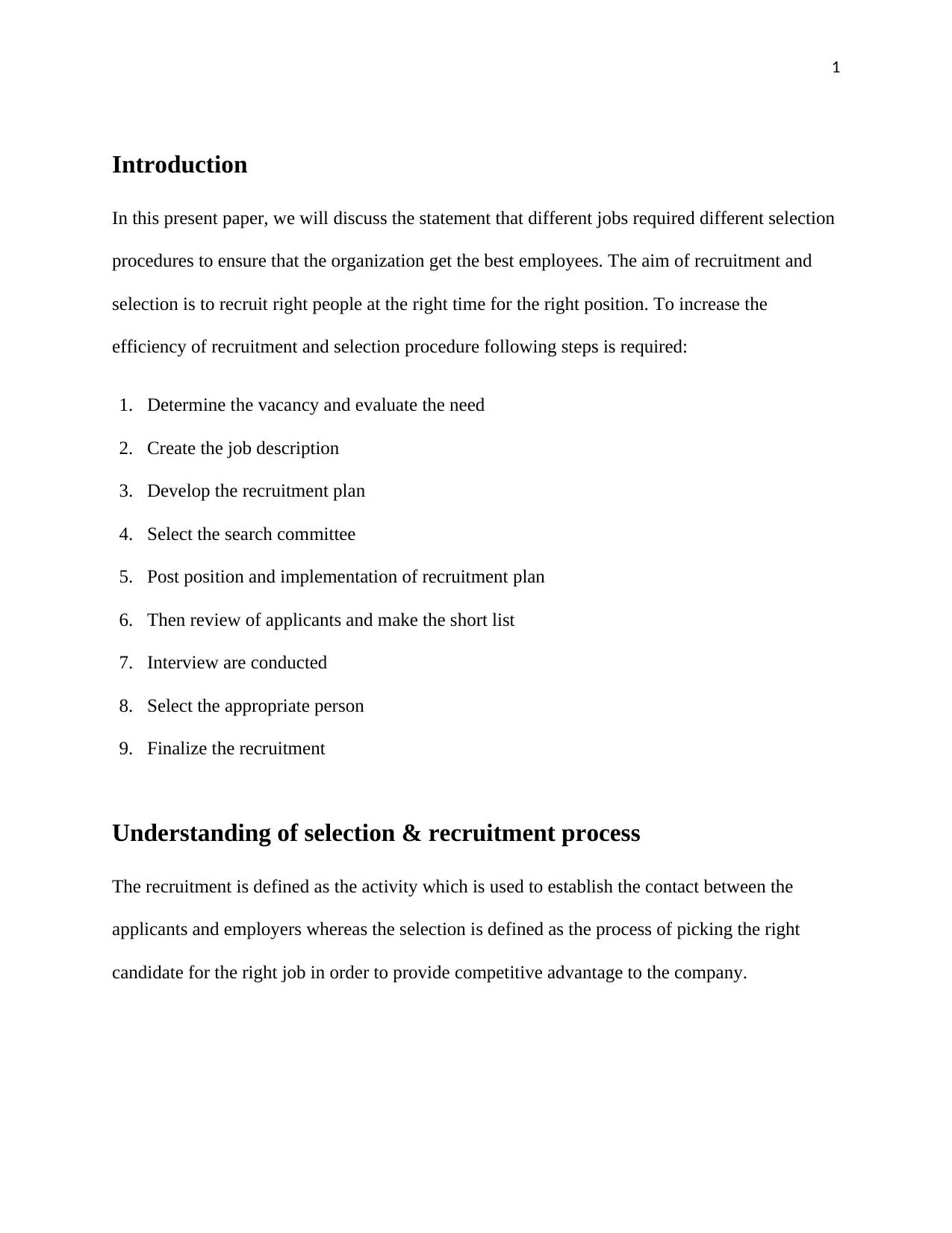
1
Introduction
In this present paper, we will discuss the statement that different jobs required different selection
procedures to ensure that the organization get the best employees. The aim of recruitment and
selection is to recruit right people at the right time for the right position. To increase the
efficiency of recruitment and selection procedure following steps is required:
1. Determine the vacancy and evaluate the need
2. Create the job description
3. Develop the recruitment plan
4. Select the search committee
5. Post position and implementation of recruitment plan
6. Then review of applicants and make the short list
7. Interview are conducted
8. Select the appropriate person
9. Finalize the recruitment
Understanding of selection & recruitment process
The recruitment is defined as the activity which is used to establish the contact between the
applicants and employers whereas the selection is defined as the process of picking the right
candidate for the right job in order to provide competitive advantage to the company.
Introduction
In this present paper, we will discuss the statement that different jobs required different selection
procedures to ensure that the organization get the best employees. The aim of recruitment and
selection is to recruit right people at the right time for the right position. To increase the
efficiency of recruitment and selection procedure following steps is required:
1. Determine the vacancy and evaluate the need
2. Create the job description
3. Develop the recruitment plan
4. Select the search committee
5. Post position and implementation of recruitment plan
6. Then review of applicants and make the short list
7. Interview are conducted
8. Select the appropriate person
9. Finalize the recruitment
Understanding of selection & recruitment process
The recruitment is defined as the activity which is used to establish the contact between the
applicants and employers whereas the selection is defined as the process of picking the right
candidate for the right job in order to provide competitive advantage to the company.
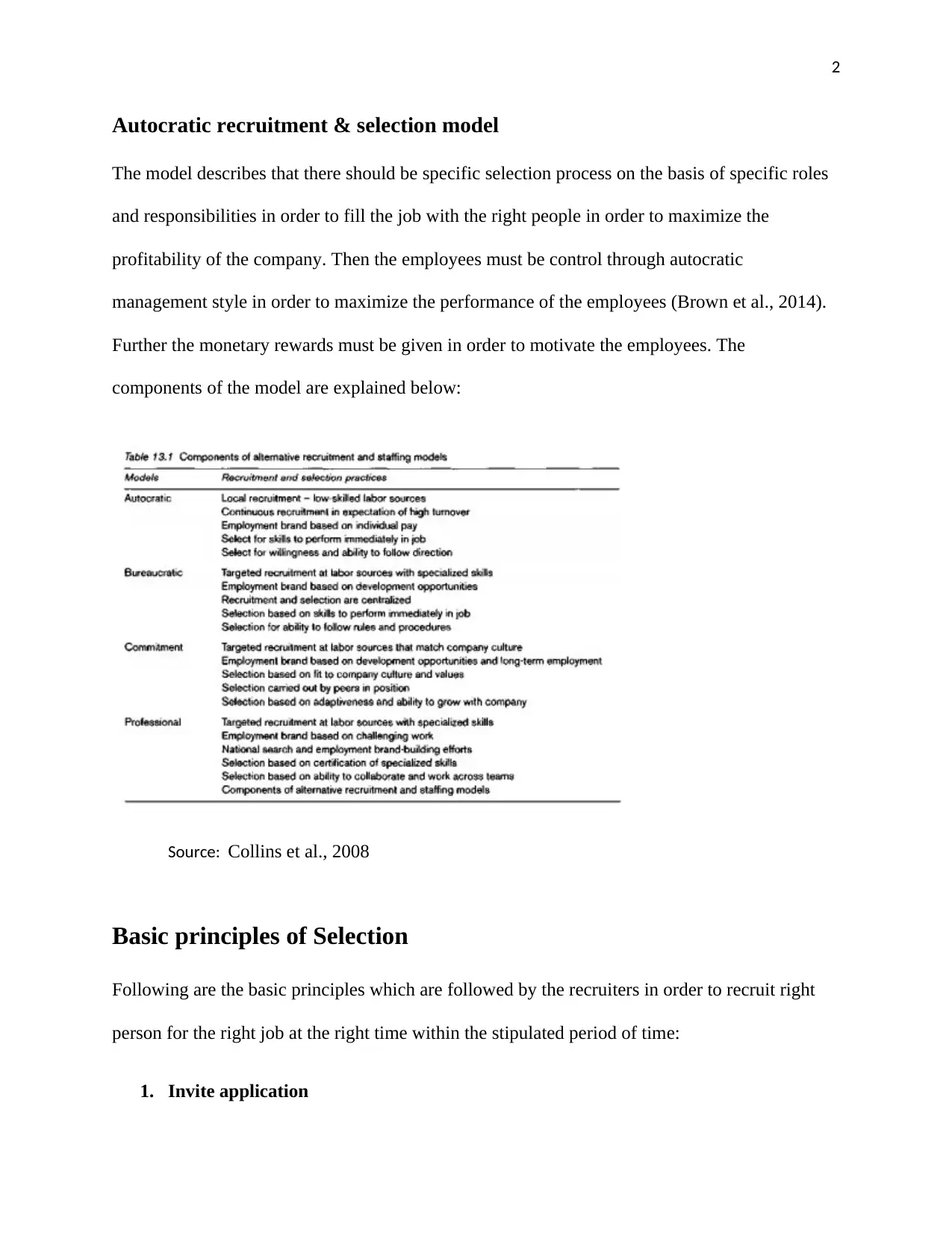
2
Autocratic recruitment & selection model
The model describes that there should be specific selection process on the basis of specific roles
and responsibilities in order to fill the job with the right people in order to maximize the
profitability of the company. Then the employees must be control through autocratic
management style in order to maximize the performance of the employees (Brown et al., 2014).
Further the monetary rewards must be given in order to motivate the employees. The
components of the model are explained below:
Source: Collins et al., 2008
Basic principles of Selection
Following are the basic principles which are followed by the recruiters in order to recruit right
person for the right job at the right time within the stipulated period of time:
1. Invite application
Autocratic recruitment & selection model
The model describes that there should be specific selection process on the basis of specific roles
and responsibilities in order to fill the job with the right people in order to maximize the
profitability of the company. Then the employees must be control through autocratic
management style in order to maximize the performance of the employees (Brown et al., 2014).
Further the monetary rewards must be given in order to motivate the employees. The
components of the model are explained below:
Source: Collins et al., 2008
Basic principles of Selection
Following are the basic principles which are followed by the recruiters in order to recruit right
person for the right job at the right time within the stipulated period of time:
1. Invite application
⊘ This is a preview!⊘
Do you want full access?
Subscribe today to unlock all pages.

Trusted by 1+ million students worldwide
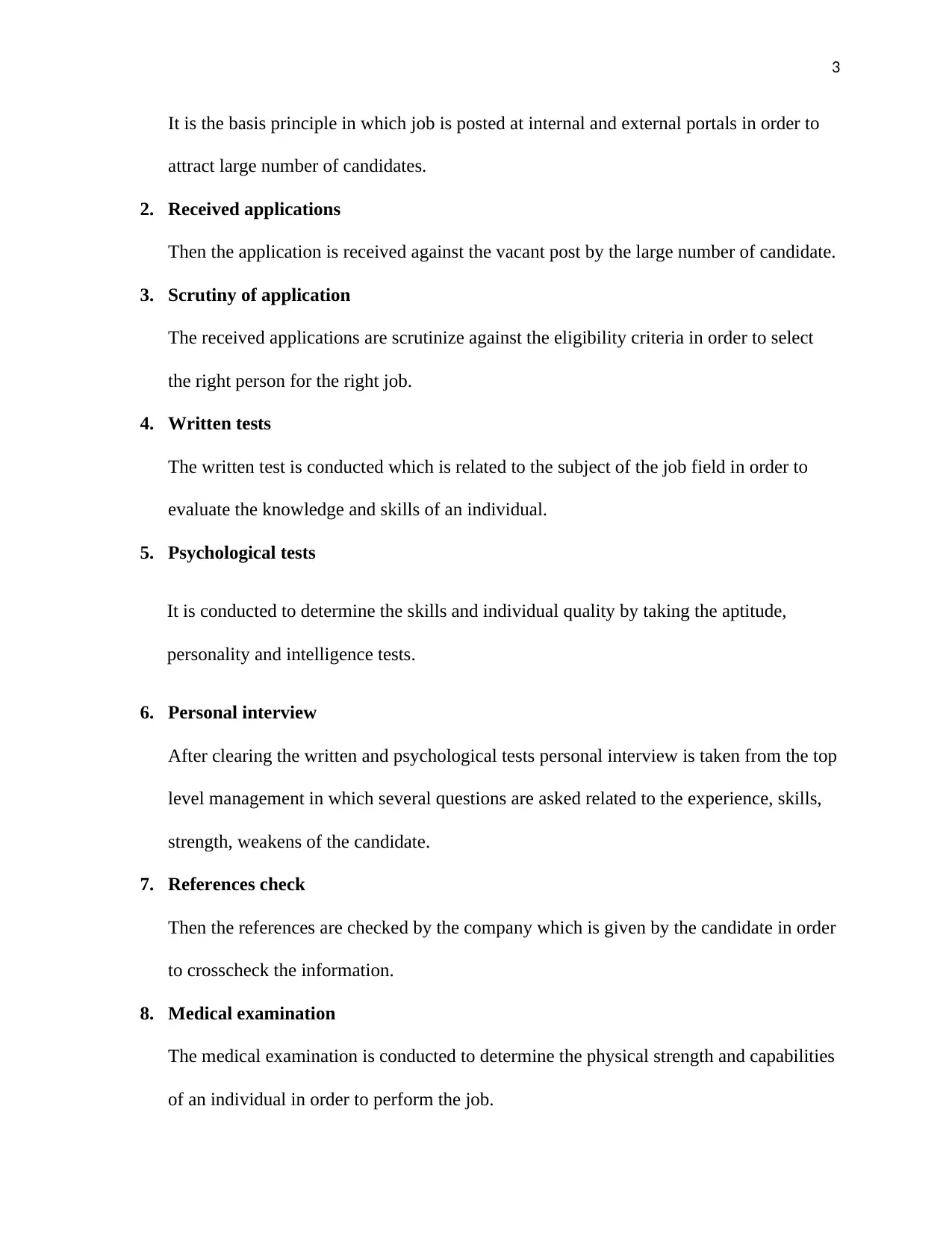
3
It is the basis principle in which job is posted at internal and external portals in order to
attract large number of candidates.
2. Received applications
Then the application is received against the vacant post by the large number of candidate.
3. Scrutiny of application
The received applications are scrutinize against the eligibility criteria in order to select
the right person for the right job.
4. Written tests
The written test is conducted which is related to the subject of the job field in order to
evaluate the knowledge and skills of an individual.
5. Psychological tests
It is conducted to determine the skills and individual quality by taking the aptitude,
personality and intelligence tests.
6. Personal interview
After clearing the written and psychological tests personal interview is taken from the top
level management in which several questions are asked related to the experience, skills,
strength, weakens of the candidate.
7. References check
Then the references are checked by the company which is given by the candidate in order
to crosscheck the information.
8. Medical examination
The medical examination is conducted to determine the physical strength and capabilities
of an individual in order to perform the job.
It is the basis principle in which job is posted at internal and external portals in order to
attract large number of candidates.
2. Received applications
Then the application is received against the vacant post by the large number of candidate.
3. Scrutiny of application
The received applications are scrutinize against the eligibility criteria in order to select
the right person for the right job.
4. Written tests
The written test is conducted which is related to the subject of the job field in order to
evaluate the knowledge and skills of an individual.
5. Psychological tests
It is conducted to determine the skills and individual quality by taking the aptitude,
personality and intelligence tests.
6. Personal interview
After clearing the written and psychological tests personal interview is taken from the top
level management in which several questions are asked related to the experience, skills,
strength, weakens of the candidate.
7. References check
Then the references are checked by the company which is given by the candidate in order
to crosscheck the information.
8. Medical examination
The medical examination is conducted to determine the physical strength and capabilities
of an individual in order to perform the job.
Paraphrase This Document
Need a fresh take? Get an instant paraphrase of this document with our AI Paraphraser
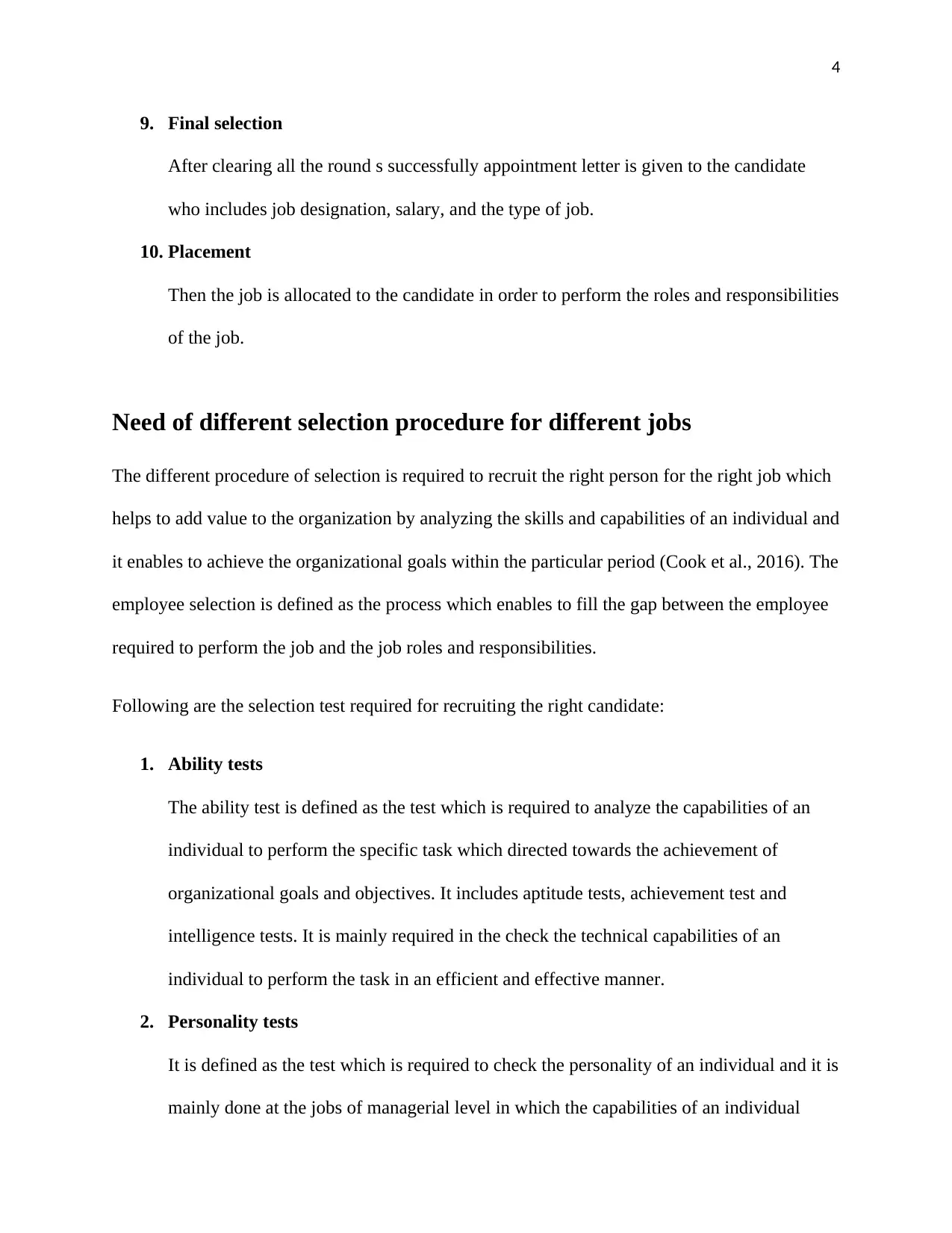
4
9. Final selection
After clearing all the round s successfully appointment letter is given to the candidate
who includes job designation, salary, and the type of job.
10. Placement
Then the job is allocated to the candidate in order to perform the roles and responsibilities
of the job.
Need of different selection procedure for different jobs
The different procedure of selection is required to recruit the right person for the right job which
helps to add value to the organization by analyzing the skills and capabilities of an individual and
it enables to achieve the organizational goals within the particular period (Cook et al., 2016). The
employee selection is defined as the process which enables to fill the gap between the employee
required to perform the job and the job roles and responsibilities.
Following are the selection test required for recruiting the right candidate:
1. Ability tests
The ability test is defined as the test which is required to analyze the capabilities of an
individual to perform the specific task which directed towards the achievement of
organizational goals and objectives. It includes aptitude tests, achievement test and
intelligence tests. It is mainly required in the check the technical capabilities of an
individual to perform the task in an efficient and effective manner.
2. Personality tests
It is defined as the test which is required to check the personality of an individual and it is
mainly done at the jobs of managerial level in which the capabilities of an individual
9. Final selection
After clearing all the round s successfully appointment letter is given to the candidate
who includes job designation, salary, and the type of job.
10. Placement
Then the job is allocated to the candidate in order to perform the roles and responsibilities
of the job.
Need of different selection procedure for different jobs
The different procedure of selection is required to recruit the right person for the right job which
helps to add value to the organization by analyzing the skills and capabilities of an individual and
it enables to achieve the organizational goals within the particular period (Cook et al., 2016). The
employee selection is defined as the process which enables to fill the gap between the employee
required to perform the job and the job roles and responsibilities.
Following are the selection test required for recruiting the right candidate:
1. Ability tests
The ability test is defined as the test which is required to analyze the capabilities of an
individual to perform the specific task which directed towards the achievement of
organizational goals and objectives. It includes aptitude tests, achievement test and
intelligence tests. It is mainly required in the check the technical capabilities of an
individual to perform the task in an efficient and effective manner.
2. Personality tests
It is defined as the test which is required to check the personality of an individual and it is
mainly done at the jobs of managerial level in which the capabilities of an individual
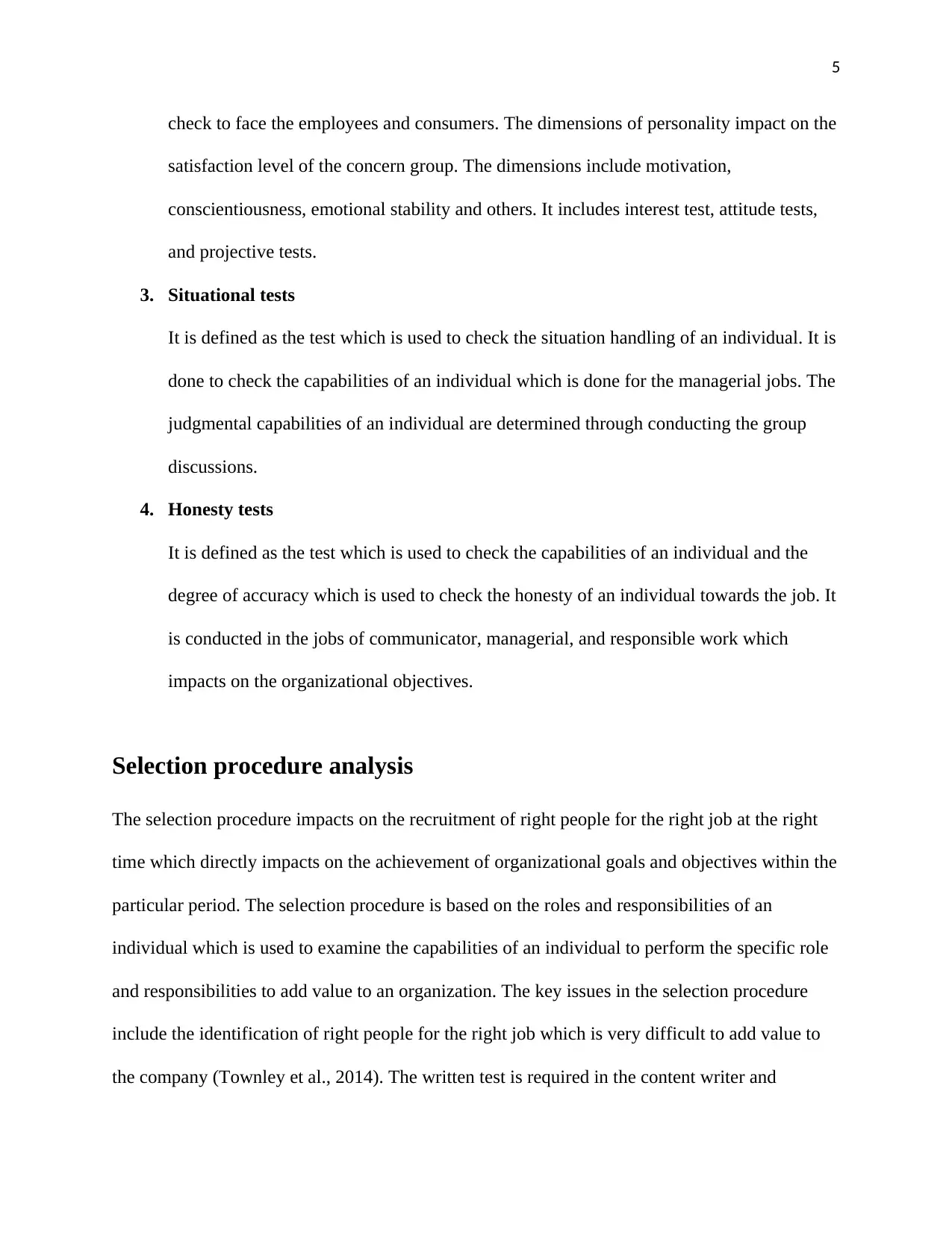
5
check to face the employees and consumers. The dimensions of personality impact on the
satisfaction level of the concern group. The dimensions include motivation,
conscientiousness, emotional stability and others. It includes interest test, attitude tests,
and projective tests.
3. Situational tests
It is defined as the test which is used to check the situation handling of an individual. It is
done to check the capabilities of an individual which is done for the managerial jobs. The
judgmental capabilities of an individual are determined through conducting the group
discussions.
4. Honesty tests
It is defined as the test which is used to check the capabilities of an individual and the
degree of accuracy which is used to check the honesty of an individual towards the job. It
is conducted in the jobs of communicator, managerial, and responsible work which
impacts on the organizational objectives.
Selection procedure analysis
The selection procedure impacts on the recruitment of right people for the right job at the right
time which directly impacts on the achievement of organizational goals and objectives within the
particular period. The selection procedure is based on the roles and responsibilities of an
individual which is used to examine the capabilities of an individual to perform the specific role
and responsibilities to add value to an organization. The key issues in the selection procedure
include the identification of right people for the right job which is very difficult to add value to
the company (Townley et al., 2014). The written test is required in the content writer and
check to face the employees and consumers. The dimensions of personality impact on the
satisfaction level of the concern group. The dimensions include motivation,
conscientiousness, emotional stability and others. It includes interest test, attitude tests,
and projective tests.
3. Situational tests
It is defined as the test which is used to check the situation handling of an individual. It is
done to check the capabilities of an individual which is done for the managerial jobs. The
judgmental capabilities of an individual are determined through conducting the group
discussions.
4. Honesty tests
It is defined as the test which is used to check the capabilities of an individual and the
degree of accuracy which is used to check the honesty of an individual towards the job. It
is conducted in the jobs of communicator, managerial, and responsible work which
impacts on the organizational objectives.
Selection procedure analysis
The selection procedure impacts on the recruitment of right people for the right job at the right
time which directly impacts on the achievement of organizational goals and objectives within the
particular period. The selection procedure is based on the roles and responsibilities of an
individual which is used to examine the capabilities of an individual to perform the specific role
and responsibilities to add value to an organization. The key issues in the selection procedure
include the identification of right people for the right job which is very difficult to add value to
the company (Townley et al., 2014). The written test is required in the content writer and
⊘ This is a preview!⊘
Do you want full access?
Subscribe today to unlock all pages.

Trusted by 1+ million students worldwide
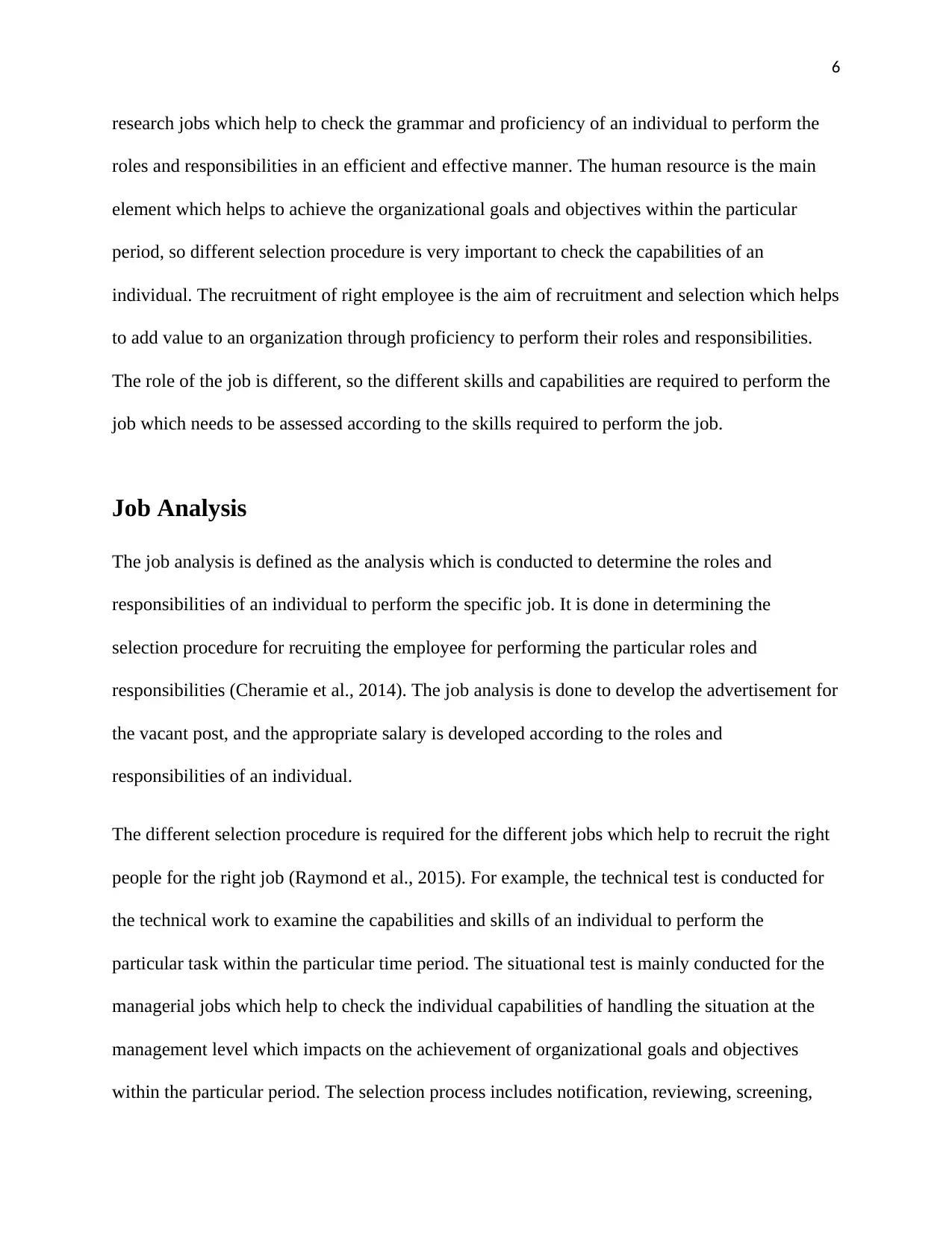
6
research jobs which help to check the grammar and proficiency of an individual to perform the
roles and responsibilities in an efficient and effective manner. The human resource is the main
element which helps to achieve the organizational goals and objectives within the particular
period, so different selection procedure is very important to check the capabilities of an
individual. The recruitment of right employee is the aim of recruitment and selection which helps
to add value to an organization through proficiency to perform their roles and responsibilities.
The role of the job is different, so the different skills and capabilities are required to perform the
job which needs to be assessed according to the skills required to perform the job.
Job Analysis
The job analysis is defined as the analysis which is conducted to determine the roles and
responsibilities of an individual to perform the specific job. It is done in determining the
selection procedure for recruiting the employee for performing the particular roles and
responsibilities (Cheramie et al., 2014). The job analysis is done to develop the advertisement for
the vacant post, and the appropriate salary is developed according to the roles and
responsibilities of an individual.
The different selection procedure is required for the different jobs which help to recruit the right
people for the right job (Raymond et al., 2015). For example, the technical test is conducted for
the technical work to examine the capabilities and skills of an individual to perform the
particular task within the particular time period. The situational test is mainly conducted for the
managerial jobs which help to check the individual capabilities of handling the situation at the
management level which impacts on the achievement of organizational goals and objectives
within the particular period. The selection process includes notification, reviewing, screening,
research jobs which help to check the grammar and proficiency of an individual to perform the
roles and responsibilities in an efficient and effective manner. The human resource is the main
element which helps to achieve the organizational goals and objectives within the particular
period, so different selection procedure is very important to check the capabilities of an
individual. The recruitment of right employee is the aim of recruitment and selection which helps
to add value to an organization through proficiency to perform their roles and responsibilities.
The role of the job is different, so the different skills and capabilities are required to perform the
job which needs to be assessed according to the skills required to perform the job.
Job Analysis
The job analysis is defined as the analysis which is conducted to determine the roles and
responsibilities of an individual to perform the specific job. It is done in determining the
selection procedure for recruiting the employee for performing the particular roles and
responsibilities (Cheramie et al., 2014). The job analysis is done to develop the advertisement for
the vacant post, and the appropriate salary is developed according to the roles and
responsibilities of an individual.
The different selection procedure is required for the different jobs which help to recruit the right
people for the right job (Raymond et al., 2015). For example, the technical test is conducted for
the technical work to examine the capabilities and skills of an individual to perform the
particular task within the particular time period. The situational test is mainly conducted for the
managerial jobs which help to check the individual capabilities of handling the situation at the
management level which impacts on the achievement of organizational goals and objectives
within the particular period. The selection process includes notification, reviewing, screening,
Paraphrase This Document
Need a fresh take? Get an instant paraphrase of this document with our AI Paraphraser
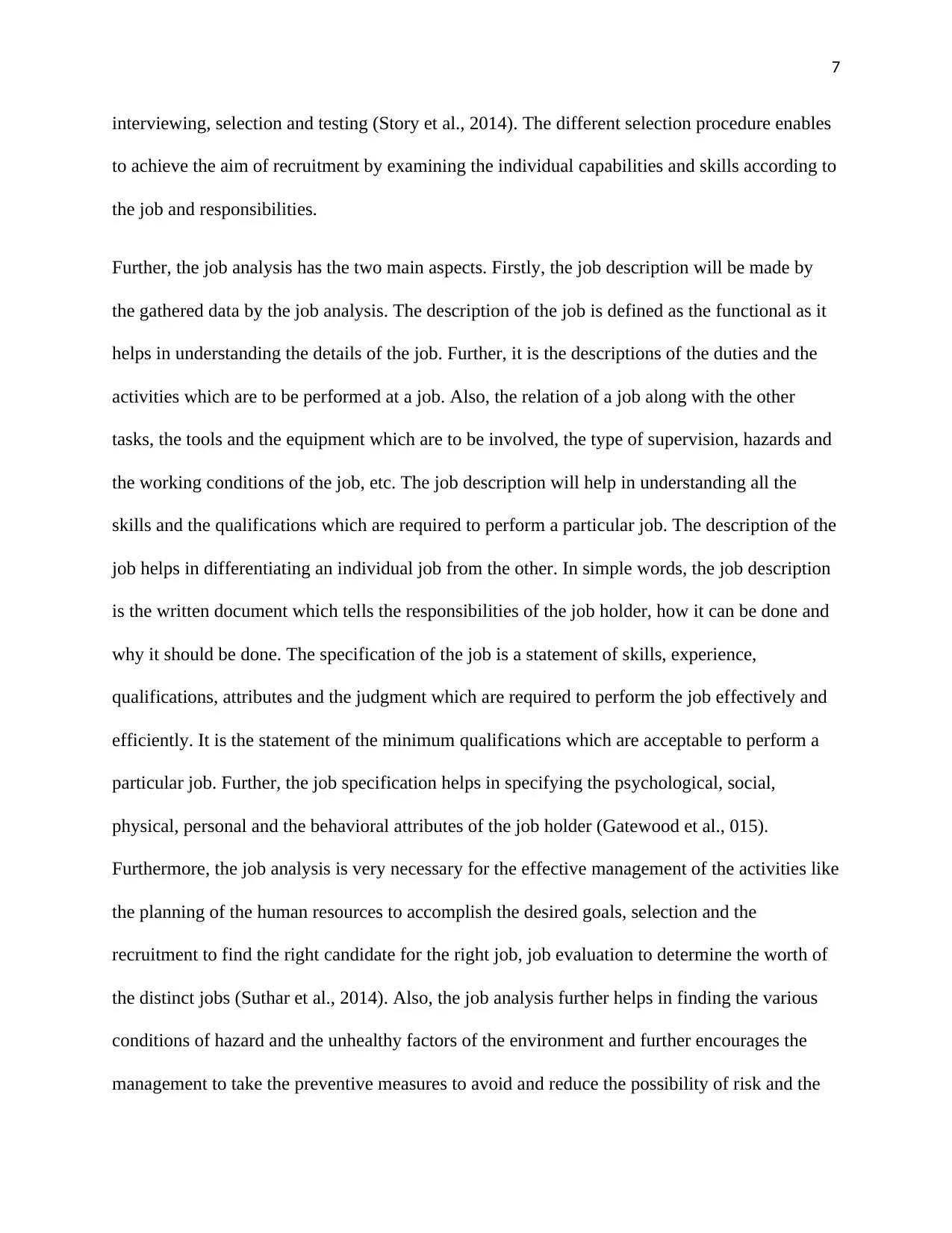
7
interviewing, selection and testing (Story et al., 2014). The different selection procedure enables
to achieve the aim of recruitment by examining the individual capabilities and skills according to
the job and responsibilities.
Further, the job analysis has the two main aspects. Firstly, the job description will be made by
the gathered data by the job analysis. The description of the job is defined as the functional as it
helps in understanding the details of the job. Further, it is the descriptions of the duties and the
activities which are to be performed at a job. Also, the relation of a job along with the other
tasks, the tools and the equipment which are to be involved, the type of supervision, hazards and
the working conditions of the job, etc. The job description will help in understanding all the
skills and the qualifications which are required to perform a particular job. The description of the
job helps in differentiating an individual job from the other. In simple words, the job description
is the written document which tells the responsibilities of the job holder, how it can be done and
why it should be done. The specification of the job is a statement of skills, experience,
qualifications, attributes and the judgment which are required to perform the job effectively and
efficiently. It is the statement of the minimum qualifications which are acceptable to perform a
particular job. Further, the job specification helps in specifying the psychological, social,
physical, personal and the behavioral attributes of the job holder (Gatewood et al., 015).
Furthermore, the job analysis is very necessary for the effective management of the activities like
the planning of the human resources to accomplish the desired goals, selection and the
recruitment to find the right candidate for the right job, job evaluation to determine the worth of
the distinct jobs (Suthar et al., 2014). Also, the job analysis further helps in finding the various
conditions of hazard and the unhealthy factors of the environment and further encourages the
management to take the preventive measures to avoid and reduce the possibility of risk and the
interviewing, selection and testing (Story et al., 2014). The different selection procedure enables
to achieve the aim of recruitment by examining the individual capabilities and skills according to
the job and responsibilities.
Further, the job analysis has the two main aspects. Firstly, the job description will be made by
the gathered data by the job analysis. The description of the job is defined as the functional as it
helps in understanding the details of the job. Further, it is the descriptions of the duties and the
activities which are to be performed at a job. Also, the relation of a job along with the other
tasks, the tools and the equipment which are to be involved, the type of supervision, hazards and
the working conditions of the job, etc. The job description will help in understanding all the
skills and the qualifications which are required to perform a particular job. The description of the
job helps in differentiating an individual job from the other. In simple words, the job description
is the written document which tells the responsibilities of the job holder, how it can be done and
why it should be done. The specification of the job is a statement of skills, experience,
qualifications, attributes and the judgment which are required to perform the job effectively and
efficiently. It is the statement of the minimum qualifications which are acceptable to perform a
particular job. Further, the job specification helps in specifying the psychological, social,
physical, personal and the behavioral attributes of the job holder (Gatewood et al., 015).
Furthermore, the job analysis is very necessary for the effective management of the activities like
the planning of the human resources to accomplish the desired goals, selection and the
recruitment to find the right candidate for the right job, job evaluation to determine the worth of
the distinct jobs (Suthar et al., 2014). Also, the job analysis further helps in finding the various
conditions of hazard and the unhealthy factors of the environment and further encourages the
management to take the preventive measures to avoid and reduce the possibility of risk and the
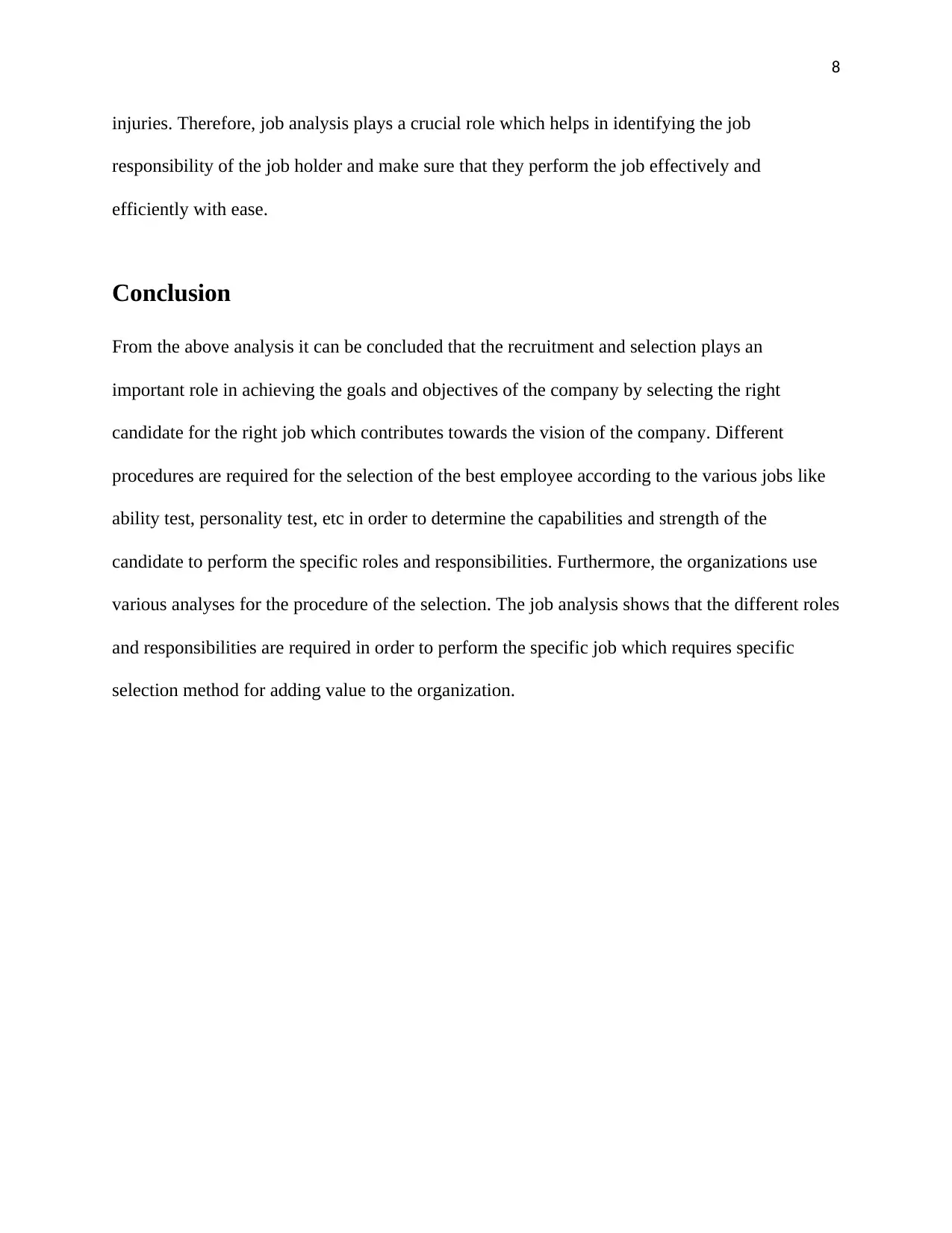
8
injuries. Therefore, job analysis plays a crucial role which helps in identifying the job
responsibility of the job holder and make sure that they perform the job effectively and
efficiently with ease.
Conclusion
From the above analysis it can be concluded that the recruitment and selection plays an
important role in achieving the goals and objectives of the company by selecting the right
candidate for the right job which contributes towards the vision of the company. Different
procedures are required for the selection of the best employee according to the various jobs like
ability test, personality test, etc in order to determine the capabilities and strength of the
candidate to perform the specific roles and responsibilities. Furthermore, the organizations use
various analyses for the procedure of the selection. The job analysis shows that the different roles
and responsibilities are required in order to perform the specific job which requires specific
selection method for adding value to the organization.
injuries. Therefore, job analysis plays a crucial role which helps in identifying the job
responsibility of the job holder and make sure that they perform the job effectively and
efficiently with ease.
Conclusion
From the above analysis it can be concluded that the recruitment and selection plays an
important role in achieving the goals and objectives of the company by selecting the right
candidate for the right job which contributes towards the vision of the company. Different
procedures are required for the selection of the best employee according to the various jobs like
ability test, personality test, etc in order to determine the capabilities and strength of the
candidate to perform the specific roles and responsibilities. Furthermore, the organizations use
various analyses for the procedure of the selection. The job analysis shows that the different roles
and responsibilities are required in order to perform the specific job which requires specific
selection method for adding value to the organization.
⊘ This is a preview!⊘
Do you want full access?
Subscribe today to unlock all pages.

Trusted by 1+ million students worldwide
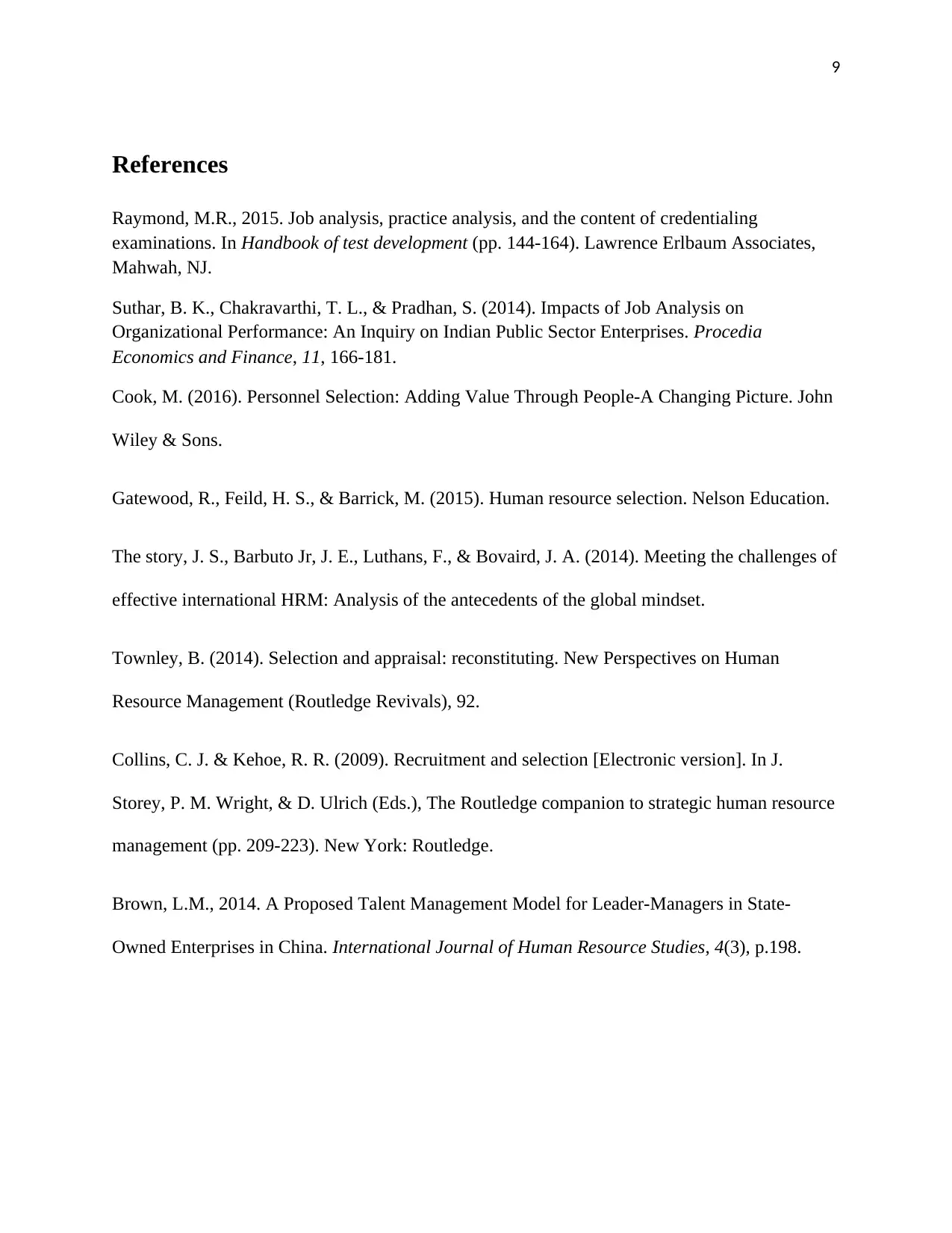
9
References
Raymond, M.R., 2015. Job analysis, practice analysis, and the content of credentialing
examinations. In Handbook of test development (pp. 144-164). Lawrence Erlbaum Associates,
Mahwah, NJ.
Suthar, B. K., Chakravarthi, T. L., & Pradhan, S. (2014). Impacts of Job Analysis on
Organizational Performance: An Inquiry on Indian Public Sector Enterprises. Procedia
Economics and Finance, 11, 166-181.
Cook, M. (2016). Personnel Selection: Adding Value Through People-A Changing Picture. John
Wiley & Sons.
Gatewood, R., Feild, H. S., & Barrick, M. (2015). Human resource selection. Nelson Education.
The story, J. S., Barbuto Jr, J. E., Luthans, F., & Bovaird, J. A. (2014). Meeting the challenges of
effective international HRM: Analysis of the antecedents of the global mindset.
Townley, B. (2014). Selection and appraisal: reconstituting. New Perspectives on Human
Resource Management (Routledge Revivals), 92.
Collins, C. J. & Kehoe, R. R. (2009). Recruitment and selection [Electronic version]. In J.
Storey, P. M. Wright, & D. Ulrich (Eds.), The Routledge companion to strategic human resource
management (pp. 209-223). New York: Routledge.
Brown, L.M., 2014. A Proposed Talent Management Model for Leader-Managers in State-
Owned Enterprises in China. International Journal of Human Resource Studies, 4(3), p.198.
References
Raymond, M.R., 2015. Job analysis, practice analysis, and the content of credentialing
examinations. In Handbook of test development (pp. 144-164). Lawrence Erlbaum Associates,
Mahwah, NJ.
Suthar, B. K., Chakravarthi, T. L., & Pradhan, S. (2014). Impacts of Job Analysis on
Organizational Performance: An Inquiry on Indian Public Sector Enterprises. Procedia
Economics and Finance, 11, 166-181.
Cook, M. (2016). Personnel Selection: Adding Value Through People-A Changing Picture. John
Wiley & Sons.
Gatewood, R., Feild, H. S., & Barrick, M. (2015). Human resource selection. Nelson Education.
The story, J. S., Barbuto Jr, J. E., Luthans, F., & Bovaird, J. A. (2014). Meeting the challenges of
effective international HRM: Analysis of the antecedents of the global mindset.
Townley, B. (2014). Selection and appraisal: reconstituting. New Perspectives on Human
Resource Management (Routledge Revivals), 92.
Collins, C. J. & Kehoe, R. R. (2009). Recruitment and selection [Electronic version]. In J.
Storey, P. M. Wright, & D. Ulrich (Eds.), The Routledge companion to strategic human resource
management (pp. 209-223). New York: Routledge.
Brown, L.M., 2014. A Proposed Talent Management Model for Leader-Managers in State-
Owned Enterprises in China. International Journal of Human Resource Studies, 4(3), p.198.
1 out of 10
Related Documents
Your All-in-One AI-Powered Toolkit for Academic Success.
+13062052269
info@desklib.com
Available 24*7 on WhatsApp / Email
![[object Object]](/_next/static/media/star-bottom.7253800d.svg)
Unlock your academic potential
Copyright © 2020–2025 A2Z Services. All Rights Reserved. Developed and managed by ZUCOL.





